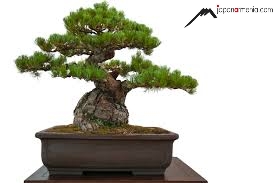
盆栽とは何ですか?
Bonsai (盆栽) are potted miniature trees which are carefully styled to achieve an aesthetic effect. The concept was first imported into Japan from China more than a thousand years ago. Since then, a distinctive style of this art form has been developed in Japan.
Various techniques such as the trimming of roots and wiring are used to keep the trees small but in proportion to how they might have looked if grown in nature. This achieves the effect of condensing the appearance of a natural tree or forest within the pot, leaving room for artistic imagination.
Typical Trees
Typical trees used in bonsai include those with needled leaves such as pine trees (matsu), with broader leaves such as maple trees (momiji), with flowers such as cherry trees (sakura), and with fruits such as quince trees (karin). Some art pieces also use grass as the subject.
Some trees purposely feature white colored, dead parts without bark to represent the struggle of a tree in nature. A partially dead trunk is called shari, while a partially dead branch is known as jin.
Styles
Bonsai come in various styles. Below are some of the most commonly encountered ones:
• Formal and Informal Straight:
The trunk in a formal straight bonsai is straight, and the pinnacle of the tree is in line with the body and the base. In case of an informal straight bonsai, the trunk slants slightly, but the top of the tree still ends up directly above the center of the base.
• Slant:
As the name suggests, the entire tree is slanted to one side.
• Cascade:
Rather than in an upright fashion, the tree grows downwards to one side to a degree where its pinnacle ends up at the same height or lower than the pot, like a tree at the edge of a cliff.
• Forest and Multi-Trunk:
In a forest style bonsai, multiple trees are grown in the same pot, carefully fashioned to mimic a forest. A multi-trunk bonsai is similar to the forest style, except that the multiple trunks have a common root, i.e. they are actually a single tree.
• Rock:
The tree grows on a rock with its roots anchored in the rock’s cracks or in the soil below.
Other Elements
The pots and stones used are also important elements in bonsai. Contrary to their Chinese counterparts, Japanese bonsai tend to use pots with less flashy colors. The idea of deriving beauty from simplicity is prized, and containers used usually have earthen or dark colors. Stones or rocks are not chosen for their rarity or value, but are selected according to how they can blend in and contribute to the aesthetics of the art piece.
http://www.japan-guide.comから取られた材料









